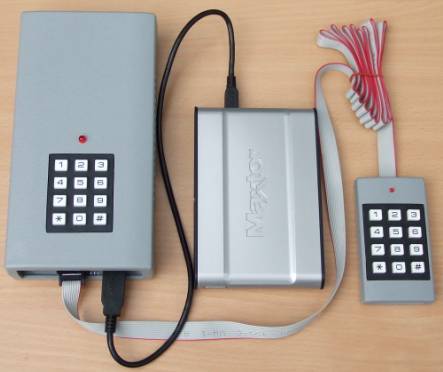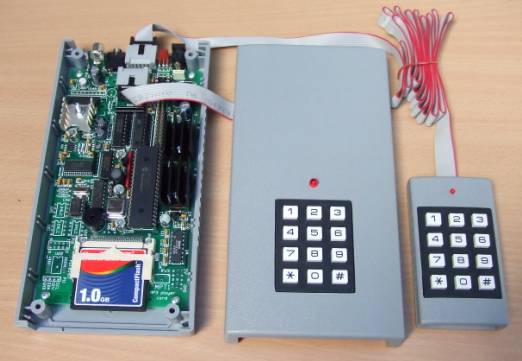MP3 player/audio archive for home and car
This player/audio archive consists of the MPT2 sound card, standard
100 x 190 mm box with a keypad, portable USB hard drive and optional extended
keypad.
The player responds
to control via a passive decimal keypad mounted on the box and/or an extended
keypad (mouse-like) connected to the playerís box with a ribbon cable. This
extended keypad has been specifically designed for use in a car. When
used in a car, it is much safer and quicker to operate the player/archive with one hand only at
the extended keypad, without taking the eyes off the road, than trying to select tracks
using tiny keys and display on a typical MP3 player.
Additionally, the player features an interface to a standard
corded or cordless telephone.
With the cordless telephone, only the base is connected to the player and
playback is controlled using the handsetís keypad.
With modern cordless phone range being several hundred meters, the
handset acts like a remote control unit with the range of up to several hundred
meters. The played audio can be
heard through the handset. Some
application may use the handset only as a remote control when the playerís
audio output is connected to a hi-fi or public address system.
It would be then possible to control the home hi-fi from the swimming
pool or the BBQ area in the backyard. The
public address system at sporting venues, lecture halls, shops and similar
places could be controlled in a similar manner.
MP3 sounds are played from USB hard drive or other USB mass storage device
like the USB stick (flash memory). The USB memory had been previously
formatted on PC with FAT16 or FAT32 and loaded with audio files.
MP3
player/audio archive based on the MPT2 sound card
Applications
* Personal sound archive/audio server for use at home or in the car
* Sound archive in museums and libraries
* An archive/server of lectures, podcasts and various recordings in education
* Learning tool for languages and other spoken material
* Information systems and interactive displays
* Audio-on-demand implementations
* Listening to podcasts and audiobooks - especially suitable for the blind or visually
impaired
Using
the MP3 player/audio archive
The audio files are accessed and navigated by commands
using single and multiple key entries.
Single key commands
2 - go back 5 sec
3 - go forward 5 sec
5 - place marker
6 - play from marker
7 - select and play previous track
8 - select and play next track
9 - play current track
# - stop or pause
Keys 2, 3, 5 and # are acted upon only when playing. Keys 6, 7 and 8
are acted upon either when playing or when stopped.
Multiple key command format
In
the multiple key commands the first key is always the star key and the last
key must be hash. The keys between the star and hash must be decimal digits
0-9.
The second key, which comes after the star key, selects the function of
the command. The decimal digits
between the second key and hash are command parameters.
A command parameter may have up to ten decimal digits.
For example, in command *015#, zero selects the function of the command
with parameter 15. After
pressing the star, the single key commands are no longer recognized. They become recognized again only after the multiple key
command is completed with the hash. If
a mistake is made during multiple key command entry, simply press the star key
and start keying again. To exit
from the multiple key command entry without execution, press the star and then
the hash key.
The pair star and hash (command *# is "no operation") can be also pressed to make sure that subsequent single or multiple key
commands will be recognized.
Multiple key
command functions
The examples below assume a simple 1-level directory
structure in the USB drive. The folders referred to in examples originate form
the Root Directory. See Audio file
management in the archive and Description of the
embedded demo audio archive for more details.
The second key is 0
in the multiple key command - play file or track number defined by the command
parameter. In this command the
parameter can be either one, two or four decimal digits long.
With one or two-digit parameter the file is played from the current
directory which can be either the Root Directory or one of the folders.
This command is acted upon when either playing or when stopped.
Example: *04# - play file number 4 in current folder. With four-digit
parameter, the first two digits select folder number and the remaining two
select the file in that folder. Example:
*06512# - select folder 65 and play file number 12 in that folder.
To play file number 16 from this folder (after it is selected with
*06512#), press
*016#.
The second key is 1
in the multiple key command - start playback of already selected file at the
time specified by the parameter. Operation of this command depends on the number of decimal
digits in the parameter:
no digits - play from the beginning,
one or two digits define playback starting time in minutes, range 0-9 min or
00-59 min
three digits define playback starting time in hours and minutes, range 0-9
hours, 00-59 min
four digits are invalid,
five digits define playback starting time in hours, min and seconds, 0-9 h,
00-59m, 00-59s
This command is acted upon either when playing or when stopped.
Examples: *126# - start playback at 26 minutes, *1205# - start playback at 2 hours and 5 minutes,
*120540# - start playback at 2 hours, 5 minutes and 40 seconds.
The second key is 2
in the multiple key command - jump back in playback time as defined by the
parameter.
Operation of this command depends on the number of decimal digits in the
parameter:
no digits - jump back 1 minute
one or two digits define the back jump in minutes, range 0-9 min or 00-59 min
three digits define the back jump in hours and minutes, range 0-9 hours, 00-59
min
This command is acted upon only when playing.
Examples: *2# - jump back 1 minute, *245#
- jump back 45 minutes, *2112# -
jump back 1 hour and 12 minutes.
The second key is 3 in the multiple key command -
jump forward in playback time as defined by the parameter.
Operation of this command depends on the number of decimal digits in
the parameter:
no digits - jump forward 1 minute
one or two digits define the forward jump in minutes, range
0-9 min or 00-59 min
three digits define the forward jump in hours and minutes, range
0-9 hours, 00-59 min
This command is acted upon only when playing.
Examples: *3# - jump forward 1 minute, *35#
- jump forward 5 minutes, *3112#
- jump forward 1 hour and 12 minutes.
Second key is 7
in the multiple key command - select folder number defined by the parameter.
Valid parameters are 00 to 99.
Parameter 00 selects the Root Directory while parameters 01 to 99
select one of the folders. This
command is acted upon when either playing or when stopped.
Example: *700# - select Root
Directory, *753# - select folder
number 53. To select and
play file number 16 in the selected folder, press *016#.
Files within current folder can be single-stepped with single key commands
7 and 8.
MP3 player based on the MPT1 sound card
The player shown
below is based on the MPT1 sound card. It consists of the MPT1 sound card, standard
100 x 190 mm box with a keypad, CompactFlash and optional extended keypad.
MP3 sounds are played from CompactFlash card which had been previously
formatted on PC with FAT16 and loaded with audio files.
Currently, only playback of files from the Root Directory is supported by MPT1.

See also Audio file management
in the archive and
Description of the embedded demo audio archive for more
details.
pdf file of this page - MP3 player/audio archive
for home and car

